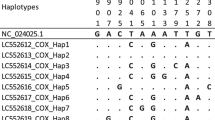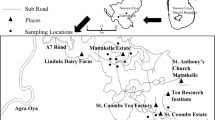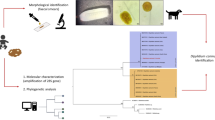Abstract
Sandflies (Diptera: Psychodidae) are medically important insects prevalent in tropical and temperate regions of the world. About 30 species of these flies have been recorded from the Western Ghats region of Kerala. While carrying out epidemiological investigations on Leishmaniasis in this region, we found two species of field-collected sandflies viz., Phlebotomus argentipes and Sergentomyia monticola infected with Tylenchid nematode parasites. The infection rates were 0.89% and 0.9%, respectively. The parasite density of nematode juvenile stages was more than 1000 in all the specimens. Both males and females were found infected. We performed molecular characterization of these nematode parasites using multiple genetic markers, mitochondrial COI, and two different regions of 18S rDNA. The genetic analysis revealed that the nematode belonged to the genus Howardula of family Allantonematidae, one infesting P. argentipes (major vector species of Leishmania) and the other, S. monticola. This is the first report of natural infection with the entomo-parasitic nematode species, belonging to Allantonematidae among these sandfly species from India. Genetically related and unclassified species of nematodes belonging to this family had been reported elsewhere from termite species. As larval stages of sandflies develop in the organic matter of termite mounds, this finding may have significant implications on their bionomics and control.
Graphical Abstract



Similar content being viewed by others
Availability of data and material
All the data submitted in this manuscript are original and available at the ICMR Vector Control Research Centre field station data bank.
References
Adler S, Theodor O (1957) Transmission of disease agents by phlebotomine sand flies. Annu Rev Entomol 2:203–226
Alves JRC, Nascimento do Carmo C, Menezes RC, Vilela ML, Santos-Mallet JRD, (2020) First report of nematodes in Lutzomyia edwardsi (Diptera: Psychodidae, Phlebotominae) in cave, in the municipality of Sumidouro. State of Rio of Janeiro, Brazil. https://doi.org/10.1101/2020.09.20.305151
Azar D, Nel A (2003) Fossil psychodoid flies and their relation to parasitic diseases. Mem Inst Oswaldo Cruz Rio De Janeiro 98(1):35–37
Bedding RA (1974) Five new species of Deladenus (Neotylenchidae), entomophagous–mycetophagous nematodes parasitic in siricid woodwasps. Nematologica 20:204–225
Bedding RA, Akhurst RJ, Kaya HK (1993) Nematodes and the biological control of insect pests. CSIRO Press, Melbourne, Australia, 178 pp
Brilhante AF, Lima de Albuquerque A, de Brito Cézar, Rocha A, Ayres CFJ, Henrique Paiva MHS, de Ávila MM, de Oliveira Cardoso C, Mauricio AL, Galati EAB (2020) First report of an Onchocercidae worm infecting Psychodopygus carrerai carrerai sandfy, a putative vector of Leishmania braziliensis in the Amazon. Sci Rep 10(1):15246–15255
Dinesh DS, Kumar V, Das P (2013) Infestation of Nematodes in Phlebotomus argentipes Annandale and Brunetti (Diptera: Psycodidae), Bihar, India. Global J Med Res Dis 13(6):7–9
Holterman M, van der Wurff A, van den Elsen S, van Megen H, Bongers T, Holovachov O, Bakker J, Helder J (2006) Phylum-wide analysis of SSU rDNA reveals deep phylogenetic relationships among nematodes and accelerated evolution toward crown clades. Mol Biol Evol 23(9):1792–1800
Hugot JP, Baujard P, Morand S (2001) Biodiversity in helminths and nematodes as a field of study: an overview. Nematology 3(3):199–208
Hurley BP, Slippers B, Wingfield MJ (2007) A comparison of control results for the alien invasive woodwasp, Sirex noctilio, in the southern hemisphere. Agric for Entomol 9:159–171
Kanzaki N, Futai K (2002) A PCR primer set for determination of phylogenetic relationships of Bursaphelenchus species within Xylophilus group. Nematology 4(1):35–44
Killick-Kendrick R, Killick-Kendrick M, Quala NA, Nawi RW, Ashford RW, Tang Y (1989) Preliminary observations of a tetradonematid nematode of phlebotomine sandflies of Afghanistan. Ann Parasitol Hum Comp 64:332–339
Kumar NP, Srinivasan R, Anish TS, Nandakumar G, Jambulingam P (2015) Cutaneous leishmaniasis caused by Leishmania donovani in the tribal population of the Agasthyamala Biosphere Reserve forest, Western Ghats, Kerala, India. J Med Microbiol 64:157–163
Kumar NP, Srinivasan R, Jambulingam P (2012) DNA barcoding for identification of sand flies (Diptera: Psychodidae) in India. Mol Ecol Resour 12(3):414–420
Lane RP (1993) Sand flies (Phlebotominae). In: Lane RP, Crosskey RW (eds) Medical insects and arachnids. Chapman and Hall, London, pp 78–119
Lannino F, Salucci S, Di Provvido A, Paolini A, Ruggieri E (2018) Bartonella infections in humans dogs and cats. Vet Ital 54(1):63–72
Lewis DJ (1978) The phlebotomine sandflies (Diptera: psychodidae) of the oriental region. Bull Br Mus (Natural History), London 1–343
McConnell E, Correa M (1964) Trypanosomes and other microorganisms from Panamanian Phlebotomus sand flies. J Parasitol 50:523–528
Poinar GO, Ferro C, Morales A, Tesh RB (1993) Anandarema phlebotophagan.gen; n.sp. (Allantonematoda: Tylenchida), a new nematode parasite of phlebotomine sand flies (Psychodidae: Diptera) with notes on experimental infections of these insects with parasitic rhabditoids Fundam. Appl Nematol 16:11–16
Qing S, Bert W (2019) Family Tylenchidae (Nematoda): an overview and perspectives. Org Divers Evol 19:391–408
Saini P, Kumar N, Ajithlal PM, Joji A, Rajesh KR, Reena KJ, Kumar A (2020) Visceral leishmaniasis caused by Leishmania donovani Zymodeme MON-37, Western Ghats, India. Emerg Infect Dis 26(8):1956–1958
Schantz PM (2004) Visceral leishmaniasis in dogs. Spinone Club of America. http://www.spinone.com/Health/Leishmaniasis/cdc_Schantz.htm
Siddiqi MR (1986) Tylenchida parasites of plants and insects, vol 645. Commonwealth Agricultural Bureaux, Farnham Royal, Slough, UK
Siddiqi MR (2000) Tylenchida: parasites of plants and insects, 2nd edn. CABI, Wallingford, UK
Srinivasan R, Jambulingam P, Kumar NP, Selvakumar M, Edwin B, Dilip Kumar T (2015) Temporal distribution and behaviour of sand flies (Diptera: Psychodidae) in a cutaneous leishmaniasis focus of the Kani Tribe settlements in the Western Ghats, India. Acta Trop 148:147–155
Srinivasan R, Jambulingam P, Vanamail P (2013) Sand fly (Diptera: Psychodidae) abundance in relation to environmental factors in parts of the coastal plains of southern India. J Med Entomol 50(4):758–763
Srinivasan R, Kumar NP, Jambulingam P (2016) Detection of natural infection of Leishmania donovani (Kinetoplastida: Trypanosomatidae) in Phlebotomus argentipes (Diptera: Psychodidae) from a forest ecosystem in the Western Ghats, India, endemic for cutaneous leishmaniasis. Acta Trop 156:95–99
Srinivasan R, Panicker KN, Dhanda V (1992) Occurrence of entomophilic nematode infestation among phlebotomid sandfly, Phlebotomies papatasi- a preliminary report. J Commun Dis 24(1):8–11
Srinivasan R, Subramanian S (2015) Sand flies diversity in association with human activities in the Kani tribe settlements of the Western Ghats, Thiruvananthapuram, Kerala, India. Mem Inst Oswaldo Cruz 110(4):174–180
Travi BL, Ferro C, Cadena H, Montoya-Lerma J, Adler GH (2002) Canine visceral leishmaniasis: dog infectivity to sand flies from non-endemic areas. Res Vet Sci 72(1):83–86
Warburg A (1991) Entomopathogens of phebotomine sand flies: laboratory experiments and natural infections. J Invert Pathol 58(2):189–202
Warburg A, Ostrovska K, Lawyer PG (1991) Pathogens of Phlebotomine sandflies: a review. Parasitologica 33:519–526
Weischer B, Brown DJ (2000) An introduction to nematodes: general nematology. A students textbook. Pensoft publishers 187 pp
World Health Organization (1975) Manual on practical entomology in malaria, part II, vol 87. WHO, Geneva, Switzerland, 947 pp
World Health Organization (2021) Leishmaniasis. Vector control. Available at www.who.int › leishmaniasis › vector-controls
Acknowledgements
We are grateful to the technical staff of ICMR Vector Control Research Centre Field Station at Kottayam for their technical help and to the Directorate of Health Services, Government of Kerala, India, for facilitating the survey.
Funding
This study was supported by the ICMR-Vector Control Research Centre intramural funding (Project grant no.: IM-1905).
Author information
Authors and Affiliations
Contributions
All Authors contributed to the study conception and design, conceived the ideas and designed the methodology. Prasanta Saini, P.M.Ajithlal, and Jessu Mathew performed the experiments. Prasanta Saini, Sonia T and N. Pradeep Kumar analysed the data and drafted the manuscript. Prasanta Saini, N. Pradeep Kumar, and Ashwani Kumar supervised the practical and theoretical works. All authors contributed to the preparation of the final manuscript and gave approval for publication.
Corresponding author
Ethics declarations
Ethics approval
The study was approved by ICMR-Vector Control Research Centre, Puducherry scientific advisory committee and no such ethics were involved in this study.
Consent to participate
Not applicable.
Consent for publication
The manuscript was approved by the research integrity unit of ICMR-Vector Control Research Centre, Puducherry. Publication related content will be provided to the journal upon acceptance of the manuscript.
Conflict of interest
The authors hereby declared that no conflict of interest is involved in this study.
Additional information
Publisher's Note
Springer Nature remains neutral with regard to jurisdictional claims in published maps and institutional affiliations.
Rights and permissions
Springer Nature or its licensor (e.g. a society or other partner) holds exclusive rights to this article under a publishing agreement with the author(s) or other rightsholder(s); author self-archiving of the accepted manuscript version of this article is solely governed by the terms of such publishing agreement and applicable law.
About this article
Cite this article
Saini, P., PM, A., Mathew, J. et al. Genetic characterization of a new entomo-pathogenic nematode (Tylenchida: Allantonematidae) parasite in wild-caught sandflies (Diptera: Psychodidae) from Western Ghats, India. Int J Trop Insect Sci 43, 2145–2150 (2023). https://doi.org/10.1007/s42690-023-01124-1
Received:
Accepted:
Published:
Issue Date:
DOI: https://doi.org/10.1007/s42690-023-01124-1




